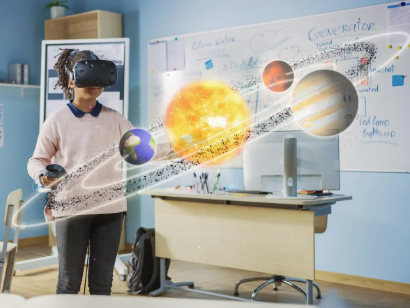Augmented Reality (AR) is transforming the way students learn by adding interactive digital elements to the physical classroom environment. Unlike Virtual Reality, which immerses users in a completely digital world, AR enhances real-world settings with layers of visual, auditory, or tactile information. In modern classrooms, AR is being adopted as an engaging educational tool that supports experiential learning and deeper student involvement.
1. Enhancing Student Engagement
AR applications allow students to interact with 3D models, explore virtual field trips, and visualize abstract concepts in ways that traditional textbooks cannot. For example, biology students can examine the human heart in 3D or manipulate cell structures to better understand their functions. These experiences make learning more immersive and memorable.
2. Supporting Different Learning Styles
Because AR provides visual, auditory, and kinesthetic input, it appeals to a wide range of learning styles. Visual learners benefit from animations and diagrams, while kinesthetic learners can engage in hands-on digital activities. This inclusive approach fosters greater comprehension and retention among diverse student populations.
3. Promoting Collaborative Learning
Many AR tools encourage group interaction and teamwork. Students can work together to solve puzzles, complete simulations, or explore virtual content using shared devices. This promotes communication, cooperation, and collective problem-solving—skills essential for success in both school and future careers.
4. Making Abstract Concepts Tangible
Complex subjects such as geometry, chemistry, and astronomy often involve ideas that are difficult to visualize. AR allows educators to bring these subjects to life by projecting interactive models into the classroom. This helps students grasp difficult concepts more quickly and with greater confidence.
5. Enabling Real-Time Feedback and Assessment
AR-based platforms can provide instant feedback through interactive quizzes and activities. Teachers can use this functionality to assess student understanding in real time and adjust instruction accordingly. It also supports formative assessment without disrupting the flow of a lesson.
6. Encouraging Creativity and Exploration
Students can use AR tools to build their own projects, design digital content, and experiment with simulations. This creative aspect nurtures innovation and encourages self-directed learning, giving students more control over how they explore and demonstrate their knowledge.
7. Expanding Access to Learning Resources
With AR, students can explore environments and artifacts that might otherwise be out of reach due to cost or geography. Virtual museum exhibits, historical reconstructions, and lab experiments become accessible through mobile devices or classroom tablets.
Conclusion
Augmented Reality is emerging as a valuable asset in modern classrooms, offering a more dynamic and inclusive approach to teaching and learning. By enhancing engagement, supporting various learning styles, and making complex topics more accessible, AR helps educators create more impactful and personalized educational experiences. As AR technology continues to evolve, it is likely to become an even more integral part of innovative classroom instruction.













